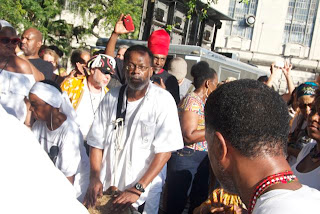 | |
| Donald "Duck" Bailey - photo courtesy of East Bay Express 11/11/09 |
"Well known as premiere time keeper of the traps, Duck also plays harmonica, has done time on the trombone and numerous other instruments," says Greg Bridges of KCSM and KPFA.
"For more than five decades, Bailey has helped define the pulse of jazz with a well-known sound having far reaching affects.
Dating back to his nine-year tenure with Hammond B3 legend Jimmy Smith from 1956-64, Bailey's influence has endured.
Having created a lithe trap set vocabulary that gave Smith room to lay down fat pedal-generated bass lines, Bailey expertly drove the thrilling crescendos that contributed to Smith becoming such a dynamic performer," stated All-About-Jazz publications.
Oakland and the Bay Area have always played a big part in the jazz and music scene.
According to Bridges, "When you think of folks like Richard Wyands, Jerome Richardson, Steve Turre, John Faddis, and Kev Choice, you think of all the places like this.
 |
The Oakland Public Conservatory of Music has given a space for young musicians. Some that may not even know they're interested find and develop the interest to learn and grow from the seasoned teachers and veterans. And, to see these young musicians go and embark on the next chapter and off to college."
 | |
| Tracy Fitzsimmons, trumpeter |
"The music I just heard these kids play inspires me," says Steve Turre.
 | |||||||
| Fredrick Douglas Youth Ensemble - Kev Choice, Director |
OPC provides year around economical study in a variety of musical arts and value innovation and scholarship in their quest to preserve the musical traditions of Oakland.
As part of their annual fundraiser, the community had an opportunity to experience known talent and make generous contributions.
OPC's own Fredrick Douglas Youth Ensemble opened the program with jazz standards and Latin jazz renditions.
Master musician Steve Turre, known as a passionate leader and one of the world's preeminent jazz innovators was the featured act.
As a member of the Saturday Night Live Band since 1984, Turre also leads several different ensembles.
The trombonist and seashellist grew up in the Bay Area where he absorbed daily doses of mariachi, blues and jazz. Turre has consistently won the "Readers and Critics" polls in JazzTimes, Downbeat, and Jazziz for "Best Trombone and Best Instrumentalist" on the shells.
After having tenured with Ray Charles and Woody Shaw, Turre was soon after brought into Art Blakey's Jazz Messengers.
Dizzy Gillespie, McCoy Tyner, J.J. Johnson, Herbie Handcock, Mongo Santamarie, and Van Morrison are only a handful of the many great musicians Turre has toured with.
 |
| Steve Turre |
 |
| Glen Pearson |
Pearson, scholar of jazz pianoism, is a native of Oakland, CA and heads the Music Studies Department at the College of Alameda. Having performed as principal keyboardist for Regina Belle, Pearson has performed with Jimmy Scott, Ernestine Anderson, Diane Reeves and a long list of jazz greats.
 |
| Steve Turre and Jeff Chambers |
Bassist, Chambers has shared the stage with luminaries such as Buddy Montgomery, Dizzy Gillespie, Les McCann, and Abbey Lincoln. Chambers has performed at many of the world's premier venues, including the Montreaux Jazz Festival, Fijitsu Jazz Festival, Monterey Jazz Festival among others.
 | |
| Donald Robinson |
Known as an active player on the San Francisco Avant-garde jazz scene, drummer, Robinson has performed and recorded with many of the great improvisational players.
From saxophonist John Tchicai, to violinist India Cook, to koto player Miya Masoaka, the classically trained perfussionist has performed with a broad range of musicians throughout Europe and the US.
In this tribute to Donald Duck Bailey, the OPC audience took a ride on Jazz's main line as Turre and the ensemble delivered heavy weight standards.
Some of the standards performed were, With A Song In My Heart, Delicious And Delightful, and Something for Sweets.
As Turre, known for swinging on trombone, magically snapped his fingers, the audience swung back to a time when jazz was ascendant in the neighborhood.
 | |
| Steve Turre |
"Jazz is all about feeling the music," says Turre.
Photos by Dinah deSpenza









































